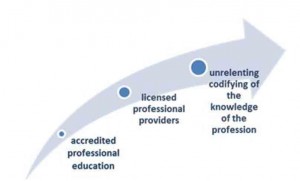A Whole New Old Baumol’s Disease in Higher Education
David J. Schleich, PhD
They learned that the tendency of costs to rise in labor-intensive sectors of the economy (such as higher education) happen alongside stagnant productivity. Higher Education workers don’t like to talk about productivity, triggered by the metaphors which liken students and their learning to widgets in assembly lines. The Higher Education sector, though, has had productivity growth rates below the economy’s average for several decades, while at the same time incurring above-average cost increases. This has endured largely because of the premium that employers have, so far – and even in the natural medicine niche – place on accredited credentials. The incentive to push production costs down (yes, economists talk about “the production of education”) comes in our case from the producers, consumers, and investors, all at the same time. Everyone wants increasing output along with greater margins for reinvesting in people, plant and equipment. In the middle of this tug of war, the “producers” are increasingly vulnerable to changes in remuneration arrangements, and the “customers” are wary of increasing, unsustainable cost. The managers of all this have very little hair left on their heads.Economics specialists 2 decades ago described a phenomenon known as “Baumol’s cost disease,” or the “Baumol Effect.” (Baumol et al, 1985) William Baumol and his colleagues analyzed the impact of differential productivity growth on the status of different economic sectors, against a backdrop of the overall economy. They found that technologically-stagnant sectors had rising relative prices and declining relative real outputs, while technologically-agile sectors reported dramatic reductions in prices (eg, cars, computers) alongside equally dramatic growth in revenue and market share.
Naturopathic Medical Education in the Higher Ed Universe
Just like higher education broadly, the cost of our ND degree has risen by about a percentage point more than inflation each year, for well over a decade now. We’re in better shape, in that regard, than our public sector colleagues, whose percentage point increase has averaged 1.6 for over a dozen years. The resulting “cost disease,” Baumol explains, can lead a stagnant sector, like higher education, to experience above-average price increases, declining quality, and persistent financial pressures which result in diminishing assets (property, equipment, innovation) and insecurity about the future. Sound familiar? Stagnant, in this case, means no real gains in productivity expressed in the cost of delivering relevant education and training.
However, naturopathic medical education has not been so stagnant all these years. Real gains in curriculum delivery, materials, and assessment quality, the professional development and performance of our teachers, plant and property facilities, ancillary educational services, and improvements in career placement are very true in our world. And, without doubt, the net-present value of an ND degree, especially in the post-Affordable Care Act (ACA) universe, is still higher than the cumulative debt load associated with a naturopathic medical degree and license. Notwithstanding our being in better shape in these categories than our public sector higher education colleagues, the future is not assured.
Despite the long-term forecasts of collapsing funding (when does the intersection of Title IV/Stafford load and debt intolerance happen?) and disruptive innovation, what would a gain in productivity look like in higher education? For one thing, it would mean lower delivery costs along with graduates better-trained for a productive economy that is transforming at warp speed. It means that our grads simply have to do as well as, and preferably better than, those who came before them, in terms of gainful employment and effectiveness in the health sector. It means an improved outcome, which means that more of our grads enter the healthcare workforce successfully, stay there, and generate more income than their predecessors. In a culture that reveres “elders” and “traditions,” this is a tough sell in the marketplace. We have some boundaries to move within this cheerless but interesting era of biomedicine pulling a classic Lazarus maneuver. That maneuver is one of co-opting our modalities and philosophy willy-nilly, and apparently with impunity. The rascals. Money and markets talk. Loudly. Often.
The Changing Alphabet Stew: (MD + DO) (ABIHM + AHMA) = AIHM
There are many factors which impact on improved outcomes, among them being the current growth in so-called “integrative medicine” alongside the growth in naturopathic graduates. These graduates are entering a healthcare terrain in which they face competition in their own scope from allopathic/biomedicine professionals. As the market for these services becomes better known, and demand finds its way into reimbursement, the MDs and DOs are not going to go away without a screaming fight. A nifty beacon for this phenomenon is the recent merger of the AHMA with the ABIHM to form the hybrid, the AIHM. That is, the American Holistic Medical Association (or AHMA, founded in 1978) is hooking up with the American Board of Integrative Holistic Medicine (only MDs and DOs are historically invited to the ABIHM party), to form the Academy of Integrative Health & Medicine (AIHM). Should we be afraid? The bottom line, truly, to watch, to see what’s likely, is this: Who trains whom in what for decades have been naturopathic protocols and modalities, eschewed and attacked by biomedicine? Concomitantly, who accredits genuine naturopathic learning in this post-ACA and now post-ABIHM world? The jury is out. These kinds of growth and change mean opportunity and danger in the same instant.
But let us get back to Baumol. Another factor in this conversation is delivery cost. The price of delivery support systems (good teachers, technological as well as student services, career services, campus facilities) rises at a rate faster than the tolerances possible in tuition increases, and faster than efficiencies and market share can soften the growing gap between discretionary and non-discretionary spending in college/program budgets. Meanwhile, our detractors are slamming headlong into our historical and emerging markets.
Higher Education and Strong Haptic Cues
The present architecture of the higher education sector is squarely facing a tipping point where the long-term benefits of designing, delivering, and credentialing learning will not easily continue to align with the benefits for its customers or its employees. The vibrations (haptic cues) are getting more intense, as states continue to reduce operational budgets and governments take on faculty unions. Professors who make their living in the higher education sector figure out, as they pencil in year after year of teaching, and as budgets slice and dice their historical entitlements, that their “professional” status is compromised constantly by not being self-regulating and not having a voluntary clientele. This latter point means that teachers are presented with students whom only a handful of faculty have had input into choosing, much less scheduling.
Additionally, even though massive open online courses (MOOCs) haven’t pushed into our world yet, once the MOOC market solidifies a formal system of accreditation, the time-place-bound higher education classroom, where our professors have some measure of autonomy once the classroom door is closed, will be disrupted substantially. Job satisfaction and career fulfillment for them and for their students will be hammered more and more by the feared and persistent debt load of their students and by the straightjacket budgets of their institutions. These pressures can interfere with the personal and professional progress and energy of the key participants, ie, students and their teachers. When this worry funnels down to career path choice for the “customer,” the threat to enrollment growth in our cohorts grows. This is especially worrying in professions where the cumulative cost of entry can include strain and stumbling in the first years of actual work. Debt service and start-up costs hijack many future key earning years.
Government Abandonment of Higher Education: Accidental or Instrumental?
During the late 1980s and throughout the 1990s in North America, state and federal budget deficits increased, coincident with popular support for tax-cutting measures. Public services were reduced, first in the welfare and poverty program areas, and eventually in appropriations for higher education. The record shows that alongside this shift in public funding for education came a concomitant rise in college and university expansion to meet demand, as well as a steady rise in non-discretionary spending (eg, instruction, technology). Many states dramatically reduced funding to their universities and colleges. Washington State, for example, in 2003 got almost two-thirds of its funding from the government; by 2013 that had fallen to one-third. The Center for the Study of Education Policy reminds us that this kind of tectonic shift in support is driving increases in both tuition and subsequent student debt load. (Trombley, 2003)
In the naturopathic medical education sector of higher education, there is no state funding, but there is student access to Title IV and Stafford Loans, as well as to private financing. In this same universe, where the Consumer Price Index doubled between 1980 and 2010, healthcare costs increased 6-fold. The expanding and regionally inconsistent price of high-tech testing, pharmaceuticals, and specialist fees have those costs continuing to spiral. Only the recent ACA changes have slowed the escalation, but the increases continue as the mainstream health sector figures out how to optimize cash flow within the new rules.
Tuition and Student Debt Load Spirals
The data also show, though, that the cost of tuition rose twice as fast as even those Consumer Price Index and healthcare costs. The National Bureau of Economic Research Institute reports that between 1978 and 2011, the purchasing power of middle class families consistently declined. (NBER, 2006) Education as a route out of these declining prospects meant larger student loans. Naturopathic college tuition has risen, in fact, over 500% since 1980, and is not immune from these same pressures despite its being on the periphery, de-linked from formal public spending.
Watching Kroton
Institutions over time rely increasingly on shorter-term commitments to faculty, avoiding full-time and tenured faculty arrangements in favor of adjunct and contract providers. Global for-profit educational deliverers like Kroton (in Brazil) have already included non-mainstream health training in their offerings, with local “hands-on” practicums complementing highly-differentiated web-streamed classes. Those classes have crisp assessment tools which fine-tune the pace the learner chooses, ranging from remediation segues to advanced webinars. They are doing this by abandoning so-called “hand-crafted,” time-place-bound teaching methods for scalable ones, and by paying star salaries to the most charismatic, dynamic lecturers and demonstrators. Couple those star personalities with superb on-line teaching materials, and the customers arrive, stay, and complete in droves.
Meanwhile, in our world, we value highly the mentoring of great clinicians and outstanding didactic presenters whose personal attention to students nurtures and nudges our cohorts through to the completion of their CNME-accredited credentials. At the same time, we often defer facilities maintenance and capital costs such as EMR/EHR (electronic medical records/electronic health records) systems because our cash reserves are wobbly. We are, overall, slower on the uptake. In the naturopathic medical education community, no tenure arrangements have developed, even though long-term perceived entitlement to recurring contracts is the norm.
The Easiest Default Button: Undervaluing the Sage on the Stage
Accompanying this worrying scenario for the educators and their managers is the long-term impact on professional development, hope for sustained investment in academic career projects (especially research and writing, supported by sabbaticals), and deep, up-to-date connections to professional formation efforts. Many faculty in naturopathic medical education programs are not strongly involved in career placement for their students, nor in professional formation efforts in their state and national associations.
As a result of all these factors, potential students and graduates of naturopathic programs, alike, think about long-haul mortgage ahead. But still they come, attracted by the power and importance of naturopathic medicine to the North American scene. They come to us and they hunker down to the work nearest, rather than to the bigger picture of disruptive educational delivery systems and the inevitable attempts by biomedicine to assimilate or destroy the naturopathic modalities and principles (a brief review of the history of the assimilation of osteopathy in the United States and the marginalizing of homeopathy in the United States will bring home the point).
Political and economic domination aside, this environment of excessive cost-pressure factors, however, is happening at a time when the opportunities for naturopathic professionals have never been better. The warping and side-railing of professional formation for the naturopathic doctor, which stopped our profession in its tracks a century back, are no longer so easy for the biomedicine industry. We have the professional formation tools well in-hand and need to continue supporting them confidently and boldly. Our efforts in the public policy and regulatory terrain are continuous and more sophisticated than ever. It is increasingly difficult for the market-focused AMA representatives in state legislative hearings to dismiss our successes in terms of accredited, rigorous education (including research), public policy, and regulatory arrangements (that is, degree credentialing approved via the very same processes as their own; licensing/certification/registration of NDs in 18 states, with more in the queue; codifying of the knowledge of the profession through much increased research and publishing activity).
The dominative US healthcare system, controlled by orthodox biomedicine at every gateway to policy and delivery, is also bruised terribly by a track record of health outcomes data that show shockingly unsustainable cost juxtaposed with alarming and unacceptable levels of chronicity. The biomedicine, pharmaceutical, and agri-business industries may enjoy the cash flow associated with millions of people on metformin; however, America cannot absorb this hijacking of the gross domestic product without long-term damage to its civil infrastructure.
Three Goals for a Stronger Profession in America
Naturopathic medical education can respond with grand impact by pursuing 3 powerful goals:
1. Expand naturopathic medical education presence in higher education by introducing ND programming into as many, appropriately-resourced and already existing post-secondary professional preparation schools as possible; we need 25 programs in constant play, producing at least 2000 new graduates every year by 2030.
2. Stick to the knitting with growing licensing/registration/certification efforts in every US state and every Canadian province; concomitantly, support international efforts to upgrade naturopathic education and practice standards with a strong presence on the WHO, and in efforts such as the ICNM bi-annual congresses; we need 25 US states and all 10 Canadian provinces licensed by 2025.
3. Enhance always, in the base budgets of existing programs year after year, 3 key educational activities: teacher training, curriculum development, and research capacity for ND professionals.
Figure 1. The 3 Pillars of Naturopathic Professional Formation
The times we live in are always interesting, no matter what the era. Our challenges belong to our time and to the place we find ourselves. We have so much more going for us now than Kuhne, Kneipp, Lust, Lindlahr, and so many of our pioneers had in their toolkits. They had an intense optimism and conviction, though, from which we might draw renewed strength a century after Abraham Flexner did his thing. Differential productivity growth, the Baumol effect, need not delay us.
References:
- Baumol, W. J., Batey Blackman, S. A., & Wolff, E. N. (1985). Unbalanced Growth Revisited: Asymptotic Stagnancy and New Evidence. The American Economic Review, 75(4). 806-817.
- Trombley, W. (2003). The Rising Price of Higher Education. College Affordability in Jeopardy. Retrieved from National Center for Public Policy and Higher Education web site: http://www.highereducation.org/reports/affordability_supplement/affordability_1.shtml.
- Nordhaus, WD. (2006). Baumol’s Diseases: A Macroeconomic Perspective, NBER Working Paper No. 12218. Retrieved from National Bureau of Economic Research website: http://www.nber.org/papers/w12218.
*****
David J. Schleich, PhD, is president and CEO of NCNM, former president of Truestar Health, and former CEO and president of CCNM, where he served from 1996 to 2003. Previous posts have included appointments as vice president academic of Niagara College, and administrative and teaching positions at St. Lawrence College, Swinburne University (Australia) and the University of Alberta. His academic credentials have been earned from the University of Western Ontario (BA), the University of Alberta (MA), Queen’s University (BEd), and the University of Toronto (PhD).











